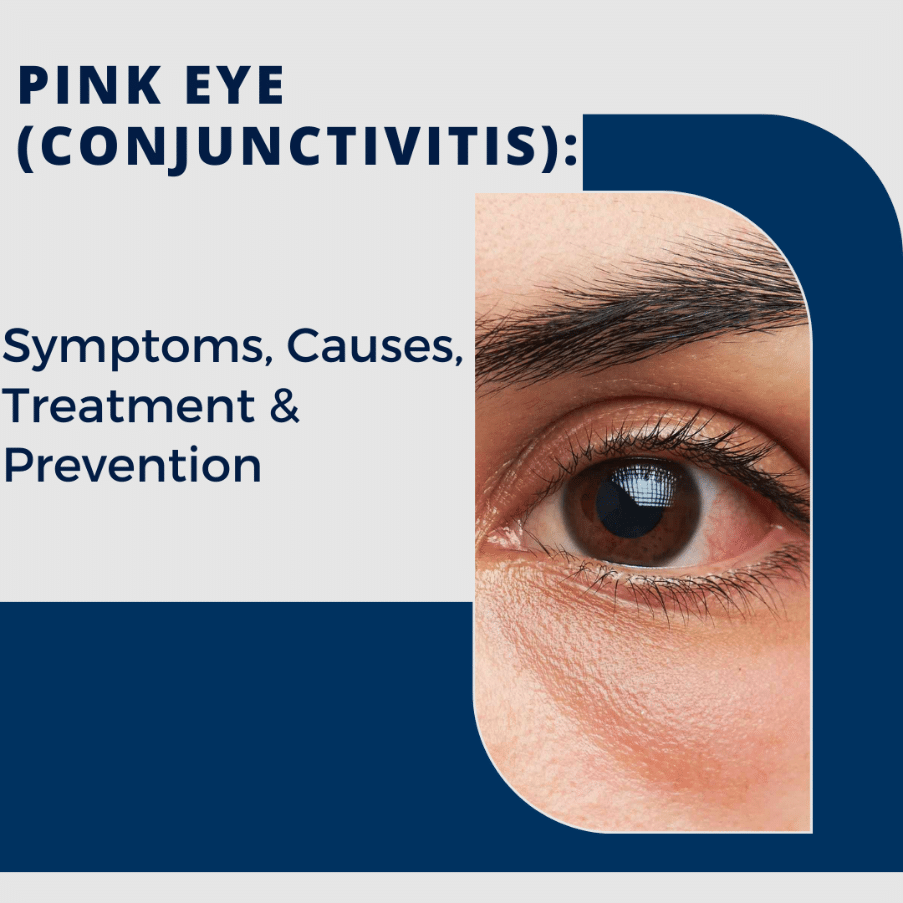Home » Blog » Pink Eye (Conjunctivitis): Symptoms, Causes, Treatment, & Prevention
Pink Eye (Conjunctivitis): Symptoms, Causes, Treatment, & Prevention
Posted by: Medical Center Ophthalmology Associates in Eye Health

Conjunctivitis, often called “pink eye,” is when the conjunctiva is irritated by an infection or allergies. Pink eye is a common eye infection affecting millions of Americans annually. Your eyes are red and swollen (inflamed), sometimes with a sticky discharge when infected. You can have conjunctivitis in one or both eyes. Some types of pink eye are very contagious (easily spread from person to person).
What Are the Causes of Conjunctivitis?
According to the American Academy of Ophthalmology, conjunctivitis can result from viruses, bacteria, or allergies. Bacterial and viral conjunctivitis types are easily spread from person to person. In contrast, allergic conjunctivitis is not contagious.
Viral conjunctivitis is the most common type of conjunctivitis. This type of pink eye is very contagious and often spreads through schools and other crowded places. It usually causes burning, red eyes with a watery discharge. Viral conjunctivitis is usually caused by the same virus that causes a runny nose and sore throat in people with the common cold.
Bacterial conjunctivitis is also very contagious. An infection from bacteria causes this form of pink eye. With bacterial conjunctivitis, you have sore, red eyes with increased sticky pus in the eye. Some bacterial infections, however, may cause little or no discharge. Sometimes, the bacteria that cause pink eye are the same that cause strep throat.
Allergic conjunctivitis is a type of pink eye that comes from an allergic reaction to pollen, animals, cigarette smoke, pool chlorine, car fumes, or something else in the environment. It is not contagious. The allergic pink eye type makes your eyes very itchy, red, and watery, and the eyelids may get puffy.
How Do You Get Conjunctivitis?
The two types of conjunctivitis that can be very contagious are bacterial and viral conjunctivitis. The most common ways to get the infectious form of pink eye include:
- Having direct contact with an infected person’s bodily fluids, usually through hand-to-eye contact.
- Not cleaning contact lenses properly. Also, using poorly fitting contact lenses or decorative contacts is a risk as well.
What Are Pink Eye Symptoms?
- Red eyes
- Lots of mucus and yellow discharge from the eye can make your eyelashes stick together, usually with bacterial conjunctivitis
- Itchy eyes
- Extra sensitive to light
- Hazy or blurry vision
- Burning eyes
- Puffy eyelids
What is the Best Treatment for Conjunctivitis?
Treating your pink eye depends solely on the type of conjunctivitis you have.
- There is no specific treatment for viral conjunctivitis. However, placing a clean, cool, wet washcloth on your eyes can help make your eyes feel comfortable.
- Your eye doctor may prescribe antibiotic eye drops for a bacterial infection that causes pink eye.
- If your conjunctivitis is due to allergies, your doctor might recommend using certain eye drops to help with itchiness and puffiness.
For the best treatment, contact your eye doctor for the best recommendation for your eye health needs and ensure you don’t have a more severe eye issue.
Tips to Protect Your Eyes From Pink Eye
We can do a few things to minimize the risk of getting pink eye.
- Wash your hands frequently and thoroughly.
- Do not sneeze or cough in your hands; aim into the crease of your elbow.
- DO NOT rub or touch your eyes.
- DO NOT share eye makeup or any eye drops.
- Take your contacts out before swimming or showering.
We Are Your Eye Health Partners
Conjunctivitis can be uncomfortable, but we are here to provide recommendations for treatment to ensure your eyes stay healthy. The best action you can take is to take the necessary steps to avoid spreading pink eye to others or getting a repeat case. Only an eye doctor can differentiate your conjunctivitis from viral, bacterial, or allergic. The treatments for the different “pink eye” types are vastly different, so we encourage you to schedule an appointment TODAY with your eye doctor to determine the proper treatment.

References: American Academy of Ophthalmology -The content is researched and vetted by the American Academy of Ophthalmology and the American Optometric Association. This blog provides information and discussion about eye health and related subjects. The content provided on this blog and any linked materials are not intended and should not be considered medical advice. If the reader or any other person has a medical concern, they should consult with an appropriately licensed physician.
